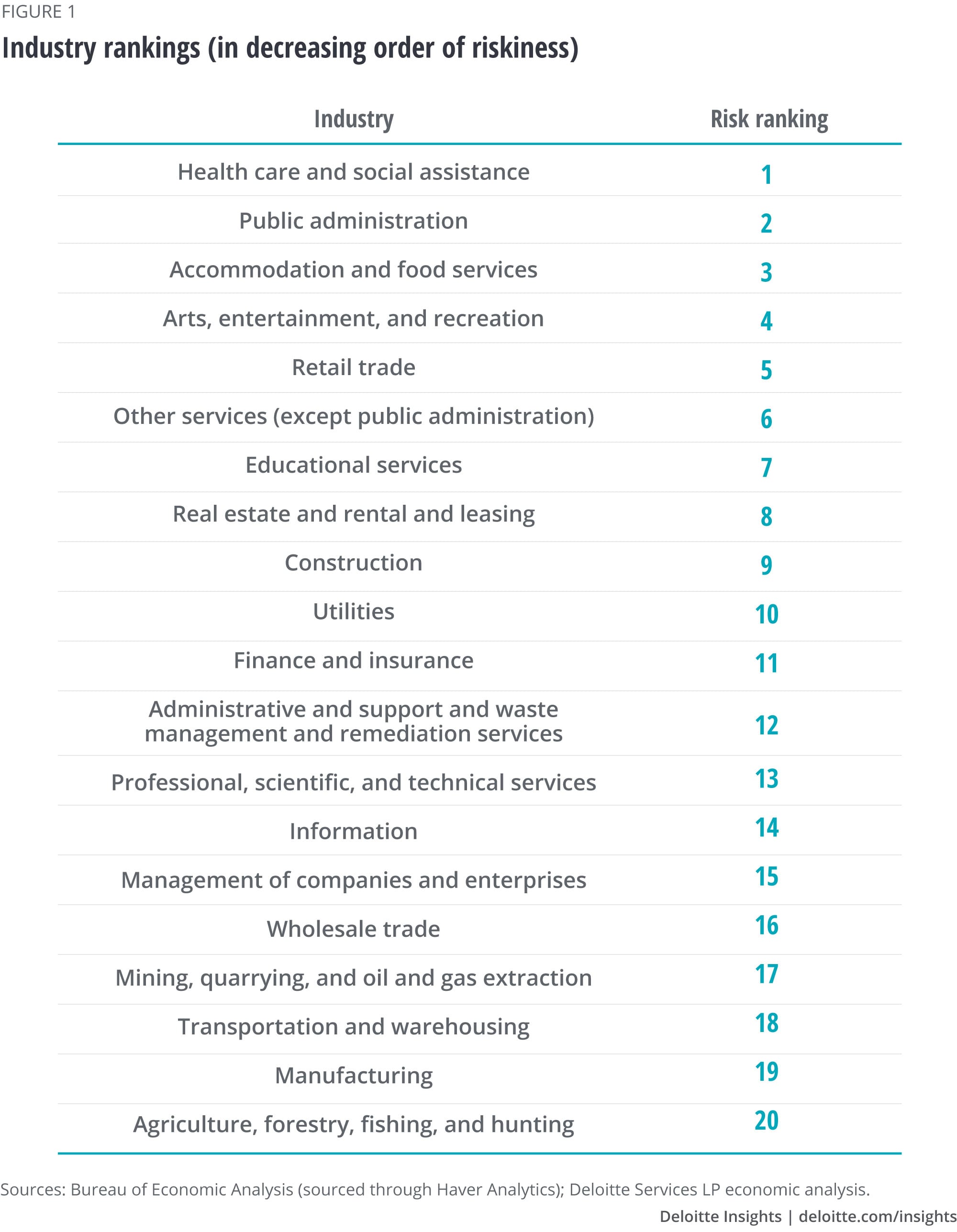
How risky is your industry? Industry risk when operating during the COVID-19 pandemic Economics Spotlight, June 2020
8 minute read
27 June 2020
With businesses reopening in parts of the United States post lockdown, it’s important to understand the health and safety risks involved as employees go back to work. We take a data-driven approach to understand the risks for 20 industries.
As parts of the United States begin to relax lockdown measures, many individual businesses are navigating through the details of how to do this while keeping their customers’ and workforce’s health and safety protocols in place. One factor that plays into how easily businesses will be able to get back to work safely is the physical safety of their employees. Do employees have to make physical contact with other people? Is it possible to enforce proper social distancing within a business location? The answer for each industry is different and will determine how difficult it will be to restart operations in that industry.
Learn more
Learn how to combat COVID-19 with resilience
Explore the Economics collection
Learn about Deloitte's services
Go straight to smart. Get the Deloitte Insights app
To understand the risk employees in different industries would face, we examined the occupational mix in each industry. Using Occupational Information Network (O*NET) data,1 we considered four key characteristics to develop an overall score for a particular industry (see sidebar, “Data brief and methodology”). These rankings do not provide a guide to which industries will open first or last but are rather a measure of the risk to employees of reopening that industry.
Data brief and methodology
For our analysis, we used data from the Occupational Employment Statistics (OES) by the Bureau of Labor Statistics (BLS) and O*NET scores. OES contains annual employment data for detailed occupations by industry. This results in about 33,000 individual occupation/employment pairs. We used the data for 2019 (latest year available), and interpolated missing data where necessary.
We measured the riskiness of each occupation by using O*NET scores for occupations from the work context category. Specifically, we looked at four sub-categories, two under “work context” and two under “physical work conditions.” The O*NET scores pertain to specific questions with respect to each occupation and sub-occupation.
Contact with others: How much does this job require the worker to be in contact with others (face-to-face, by telephone, or otherwise) in order to perform it?
Face-to-face discussions: To what extent does this job require the worker to perform face to face discussions with other people?
Exposed to disease or infections: How often does this job require exposure to disease/infections?
Physical proximity: To what extent does this job require the worker to perform job tasks in close physical proximity to other people?
The O*NET database contains scores (scale ranging from 0 to 100) of much granular occupations (up to 6-digit coding) within an industry, so we computed a simple sum of the scores after transforming each score to 0-1 for the four dimensions. We then calculated weighted scores for each two-digit industry based on the number of workers in each occupation in the industry and the risk score for the occupation.
The challenges in reopening will vary significantly within each industry because we have used broad industry designations. For example, health care occupations vary within the health care industry; pathologists have a relatively low score of physical proximity compared to surgical technologists or general dentists. Similarly, within accommodation and food services, occupations such as cooks or dishwashers have relatively low contact with others compared to food-serving workers. Given the present uncertainty, much will depend on how individual businesses can adopt a safe playbook to adjust to the new normal.
Figure 1 shows industry rankings, from those with high-risk occupations to those with the least risky occupations. The discussion below explains some of the drivers of this evaluation by industry.

Health care and social assistance: Not surprisingly, health care and social assistance is the highest-risk industry, as 61% of the industry workforce are health care practitioners who have high physical contact with others daily. This occupation also has a very high score for exposure to disease or infections. Office and administrative support, and community and social services are the other two common occupational categories. While office and administrative support occupations have a low score for exposure to diseases, community and social services tend to have a very high score for face-to-face discussions on the job and a medium score for exposure to diseases.
Public administration: Public administration is a surprisingly high-risk industry. About 20% of employees work in protective services occupations that have a high score for contact with others and require face-to-face discussions on the job. The other major occupations in public administration are office and administrative support, business and financial operations, management, health care practitioners, and community and social services. The latter two occupations have high scores for exposure to diseases and require face-to-face discussions on the job.
Accommodation and food services: About 80% of the industry workforce are employed in food preparation, building and ground cleaning, and personal care occupations, which have high scores for contact with others, and require face-to-face discussions on the job. The other common occupations are sales-related and office and administrative support, which employ fewer workers.
Arts, entertainment, and recreation: This is a relatively high-risk industry. Common occupations in arts and recreation are personal care and service; food preparation and building; office and administrative support; and arts, design, and entertainment. Many of these have medium-to-high scores for face-to-face discussions on the job and contact with others. For example, 31% of employees in the industry work in personal care and service occupations that have high scores for physical proximity and contact with others.
Retail trade: About 90% of the employees in retail trade work in occupations that have medium or high scores for physical proximity and contact with others. Sales and related occupation—comprising 55% of the industry workforce—have a high score for contact with others and require physical proximity. Other common occupations are transportation and material moving and office and administrative support, which have medium scores for physical proximity and contact with others.
Other services (except public administration): Other services include repair and maintenance; personal and laundry; religious, grantmaking, civic, professional, and similar organizations; etc. Common occupations in the industry require a certain degree of physical contact. More than 20% of employees work in personal care and service occupations that tend to have high scores for contact with others and face-to-face discussions on the job. Other common occupations (comprising 44% of the workforce) have medium-to-high scores for face-to-face discussions and contact with others.
Educational services: Employees in education largely work as teachers and in related occupations (59% are in education, training, and library occupations). Smaller numbers work in office and administrative support (9%), and management (5%) occupations. Education and training occupations have high scores for face-to-face discussions on the job and contact with others. Office and administrative support occupations have medium risk scores.
Real estate and rental and leasing: Common occupations in the real estate industry are sales and related occupations; office and administrative support; and installation, maintenance, and repair occupations. About 66% of the workforce are employed in these occupational categories that have medium scores for physical proximity. A lower percentage of employees (25%) are employed in relatively lower-risk occupations such as management, business and financial operations, and building and ground cleaning.
Construction: More than 60% of the employees in this industry are employed in construction and extraction occupations that have medium scores for contact with others and physical proximity. The other two common occupations—office and administrative support, and installation and maintenance (9% each)—also have medium scores for contact with others and relatively low scores for physical proximity.
Utilities: Common occupations in utilities such as installation, maintenance, and repair, and office and administrative support account for a little over 43% of employees in this sector and have medium scores for physical proximity and contact with others. For example, employees in the installation and maintenance occupation tend to come across different people regularly and so has a medium score for physical proximity. Other occupations, including management, business and financial operations, and architecture and engineering, which require a lesser degree of physical contact, make up 40% of overall employees.
Finance and insurance: More than half of the industry workforce (54%) are employed in office and administrative occupations, and sales and related occupations that have medium scores for face-to-face discussions and physical proximity. Workers in the sales and related category (16%) usually have higher chances of meeting new people and have a high score for contact with others. The other common occupations such as management, business and financial operations, and computer and mathematical science operations have a lower degree of physical contact.
Administrative and support and waste management and remediation services: This industry is split among 12 diverse occupations, seven of which require a high degree of proximity with others and five that do not require proximity in day-to-day operations. Occupations such as office and administrative support, transportation and material moving, and sales and related occupations have medium scores of physical proximity, while protective services occupations have a high score for face-to-face discussions. These occupations together employ more than half, or 56%, of the employees. The other common occupations (for example, building and ground cleaning, and business and financial operations) also have relatively medium scores for physical proximity and face-to-face discussions on the job.
Professional, scientific, and technical services: Common occupations in the professional services industry are computer and science operations, office and administrative support, business and financial operations, architecture and engineering, and management. Together these occupations employ more than 70% of employees in this industry. Most of these occupations have medium-to-low scores for physical proximity. Other common occupations in the industry, such as office and administrative support occupations—employing 17% of employees—require some degree of contact with others.
Information: More than 80% of the employees in this sector work across six occupational groups—management; business and financial operations; computer and mathematical science operations; arts, design, entertainment, and other media; sales and related; and office and administrative support. Several of these occupational groups (such as management, business and financial operations, and computer and mathematical science operations) have low scores for contact with others and physical proximity and employ 38% of the industry’s workforce. Other common occupations in the industry (such as arts, design, and media; sales and related; and office and administrative support) have medium scores for contact with others.
Management of companies and enterprises: More than 75% of this industry’s workforce work in business and financial operations, office and administrative support, management, and computer and mathematical science operations occupations. Three of these occupational categories—employing more than 50% of employees—have medium scores for physical proximity. The office and administrative support occupation involves some degree of contact with others and hence has a high score for face-to-face discussion and contact with others.
Wholesale trade: Common occupations in wholesale trade are transportation and material moving, sales and related, and office and administrative support. Together they account for 66% of the total workforce. These occupations have medium scores for physical proximity and contact with others.
Mining, quarrying, and oil and gas extraction: More than 60% of the employees are engaged in occupations such as construction and extraction, transportation and material moving, and office and administrative support, which require some degree of physical contact with others. Construction and extraction occupations alone have medium scores for contact with others, and accounts for 41% of employees.
Transportation and warehousing: The most common occupations in this industry are transportation and warehousing; office and administrative support; and installation, maintenance, and repair occupations, which have medium scores for physical proximity. Transportation occupations alone account for 62% of total employees and have a medium score for physical proximity.
Manufacturing: The most common occupations in manufacturing are production occupations, employing more than 50% of this industry’s workforce. Production occupations have a relatively low score for face-to-face discussions, contact with others, and physical proximity. Other common manufacturing occupations such as transportation and material moving, and office and administrative support tend to have medium scores for contact with others.
Agriculture, forestry, fishing, and hunting: More than 70% of employees in this industry are engaged in farming, fishing, and forestry occupations that have low scores for contact with others and face-to-face discussions. This makes it the lowest-risk industry at this level of classification.
© 2021. See Terms of Use for more information.
Explore our COVID-19 content
-
The heart of resilient leadership: Responding to COVID-19 Article5 years ago
-
Embedding trust into COVID-19 recovery Article4 years ago
-
The essence of resilient leadership: Business recovery from COVID-19 Article4 years ago
-
Transforming government post–COVID-19 Article4 years ago
-
Staying grounded in uncertain times Podcast4 years ago
-
COVID-19 and the undisruptable CEO Article4 years ago


















